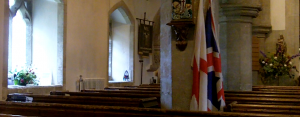
Chapter 7 of the new book, How to Pray from HarperOne, begins four chapters that are excerpts from C. S. Lewis’s famous book, The Screwtape Letters. Prayer is such an important part of the Christian life that it is obvious the devil would want to hinder it or spoil it. In the process of evaluating this demonic strategy, Lewis has a lot of good practical advice to improve our praying.
The chapter is taken from Letters 3 and 4 to Wormwood. It begins with the third paragraph of Letter 3, and continues with the whole of Letter 4. The two letters have in common the problem of distinguishing between what we perceive in our own psyche as real and important spiritually, versus what is actually real and important as we are taught in the Gospel.
The paragraph from Letter 3 of Screwtape, is about the possibility of losing the connection between how we pray for someone and how we actually treat them. The subject is the “patient’s” mother, and you just can’t help but think about Lewis’s relationship with Mrs. Moore when you read this letter.
The lessons from Letter 4 are:
1 – Beware of a false concept of prayer, such as was advocated by the poet Coleridge, whom Lewis – amusingly – quotes.
2 – Do not equate feelings that may be generated in prayer with true prayer.
3 – Recognize how our false concepts about God and prayer can keep us from truly “dealing” with God.
This last lesson comprises a lot of what Lewis has to say about prayer in Letters to Malcolm. Lewis’s chief concern in much of that book is how to get ourselves into the real presence of God, so our true self is relating to his true Self. These lines from Letter 4 of Screwtape (pp. 72-73 of HTP) encapsulize this critical distinction:
For if he ever comes to make the distinction, if ever he consciously directs his prayers ‘Not to what I think thou art but to what thou knowest thyself to be’, our situation is, for the moment, desperate. Once all his thoughts and images have been flung aside or, if retained, retained with a full recognition of their merely subjective nature, and the man trusts himself to the completely real, external, invisible Presence, there with him in the room and never knowable by him as he is known by it – why, then it is that the incalculable may occur.
Understanding this concern of Lewis’s is extremely important, not only for our prayer life, but for the whole of our walk with God. The instruction of our Lord to “watch and pray” – among other things – is a call to be sure we are thinking about what we are doing, and rightly understanding it. Being aware of these kinds of potential mistakes in our thinking, which Lewis here illumines, is of great benefit in this endeavour.
Reference: C. S. Lewis, How To Pray: Reflections and Essays, (New York, HarperOne, 2018), ISBN-13: 978-0062847133.
————————–
Please note that the content and viewpoints of Rev. Beckmann are his own and are not necessarily those of the C.S. Lewis Foundation. We have not edited his writing in any substantial way and have permission from him to post his content.
————————–
 The Rev. David Beckmann has for many years been involved in both the Church and education. He helped to start a Christian school in South Carolina, tutored homeschoolers, and has been adjunct faculty for both Covenant College and the University of Tennessee, Chattanooga. He founded the C.S. Lewis Society of Chattanooga in 2005. He has spoken extensively on C.S Lewis, and was the Director of the C.S Lewis Study Centre at The Kilns from 2014-2015. He is currently a Regional Representative for the C.S. Lewis Foundation in Chattanooga.
The Rev. David Beckmann has for many years been involved in both the Church and education. He helped to start a Christian school in South Carolina, tutored homeschoolers, and has been adjunct faculty for both Covenant College and the University of Tennessee, Chattanooga. He founded the C.S. Lewis Society of Chattanooga in 2005. He has spoken extensively on C.S Lewis, and was the Director of the C.S Lewis Study Centre at The Kilns from 2014-2015. He is currently a Regional Representative for the C.S. Lewis Foundation in Chattanooga.